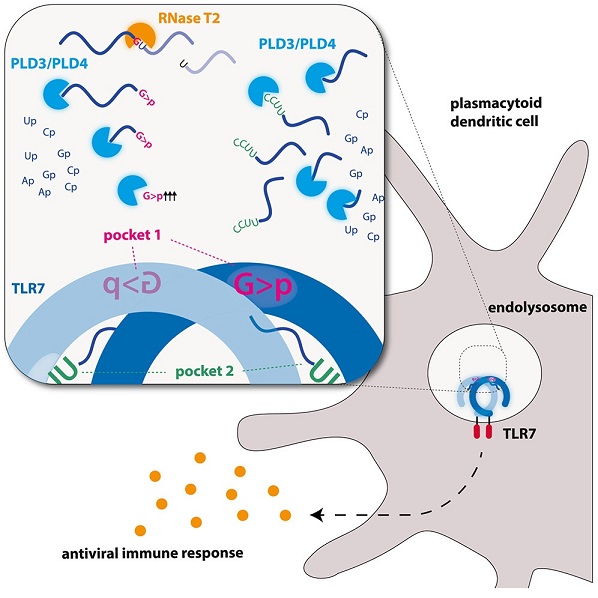New Breakthrough In Deciphering The Complex Activation Mechanism Of Toll-Like Receptor 7 (TLR7)
Nikhil Prasad Fact checked by:Thailand Medical News Team May 07, 2024 11 months, 3 weeks, 2 days, 5 hours, 32 minutes ago
Medical News: Unlocking the Intricacies of RNA Recognition
The innate immune system is a sophisticated defense mechanism that plays a critical role in protecting the body against various pathogens, including viruses. Among the key players in this system is Toll-like receptor 7 (TLR7), an immune receptor found in dendritic cells responsible for recognizing single-stranded viral RNA and initiating inflammatory responses. Recent groundbreaking research led by scientists at Ludwig Maximilian University of Munich (LMU)-Germany that is covered in this
Medical News report has shed light on the intricate machinery behind TLR7 activation, uncovering the essential role of several enzymes in this process.
 Graphical Abstract - Breakthrough In Deciphering The Complex Activation Mechanism Of Toll-Like Receptor 7 (TLR7)
The Significance of TLR7 in Innate Immunity
Graphical Abstract - Breakthrough In Deciphering The Complex Activation Mechanism Of Toll-Like Receptor 7 (TLR7)
The Significance of TLR7 in Innate Immunity
TLR7 is a pivotal component of the innate immune system, crucial for detecting non-self RNA, particularly from viral sources. Dysfunctions in TLR7 activation have been implicated in autoimmune diseases, emphasizing the importance of understanding its activation mechanism. LMU researchers, led by Professor Veit Hornung and Marleen Bérouti, delved into the complex interplay of enzymes involved in RNA recognition by TLR7, aiming to decipher the molecular mechanisms governing this vital immune response.
Unveiling the Molecular Players
The researchers employed a multidisciplinary approach, combining cell biology techniques with cryogenic electron microscopy, to unravel the molecular intricacies of TLR7 activation. They discovered that the recognition of foreign RNA by TLR7 relies on the coordinated activity of multiple enzymes, including the endonuclease RNase T2 and the exonucleases PLD3 and PLD4 (phospholipase D3 and D4). This collaborative effort among enzymes is essential for processing RNA molecules into smaller fragments that can bind to TLR7 and initiate immune signaling.
Role of Endonucleases and Exonucleases in RNA Processing
Endonucleases, such as RNase T2, play a critical role in cleaving RNA molecules in the middle, generating fragments with exposed ends. These fragments are then further processed by exonucleases like PLD3 and PLD4, which cleave the RNA from one end to the other, producing smaller RNA snippets. This concerted action results in the generation of RNA ligands that can bind to specific pockets on TLR7, triggering downstream immune responses.
Mechanistic Insights into TLR7 Activation
The researchers' findings provided a mechanistic basis for understanding how RNA fragments generated by RNase T2 and PLD exonucleases activate TLR7. Specifically, RNase T2 generates guanosine 2′,3′-cyclic monophosphate-terminated RNA fragments, which serve as ligands for one of TLR7's binding pockets. The PLD exonucleases, on the other hand, release terminal 2′,3′-cyclic guanosine monophosphate (2',3'-cGMP) and generate RNA fragments for a
nother binding pocket on TLR7. This orchestrated process is essential for initiating the immune signaling cascade upon RNA recognition.
Balancing Immune Responses: Dual Role of PLD Exonucleases
Interestingly, the PLD exonucleases exhibit a dual role within immune cells. While they promote inflammation through TLR7 activation, they also have an anti-inflammatory effect through another immune receptor, TLR9. This dual functionality underscores the finely tuned balance required for appropriate immune responses and suggests potential therapeutic targets for modulating immune pathways.
Implications for Therapeutic Strategies
The comprehensive understanding of RNA recognition by TLR7 and the involvement of specific enzymes opens up avenues for targeted therapeutic interventions. Modulating the activity of RNase T2, PLD3, and PLD4 could potentially regulate immune responses, offering novel strategies for managing autoimmune diseases and viral infections.
Future Directions and Limitations
Despite the significant insights gained, further research is needed to fully elucidate the precise RNA fragments recognized by TLR7 and explore the role of other enzymes, such as the RNase A family, in this process. Additionally, investigating the impact of enzyme dysregulation on immune dysfunctions will provide valuable insights into potential therapeutic avenues.
Conclusion
The collaborative effort of RNase T2, PLD3, and PLD4 in generating RNA ligands for TLR7 activation highlights the complexity of innate immune responses. Understanding these molecular interactions not only enhances our knowledge of immune surveillance mechanisms but also holds promise for developing targeted therapies to modulate immune pathways effectively. The ongoing exploration of RNA recognition by TLR7 paves the way for innovative strategies in immunotherapy and autoimmune disease management.
The study findings were published in the peer reviewed journal: Immunity.
https://www.cell.com/immunity/fulltext/S1074-7613(24)00215-2
For the latest about the Innate Immune System, keep on logging to Thailand
Medical News.
